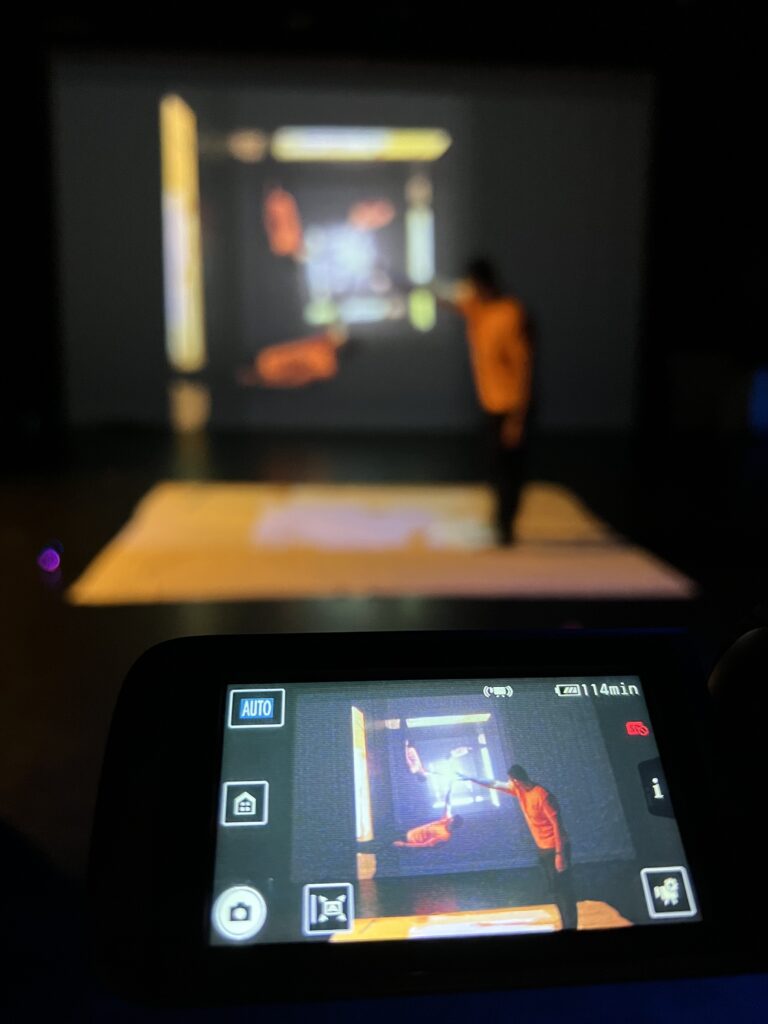cycle 1: infinite seeing : feedback loops
Posted: October 31, 2022 Filed under: Uncategorized Leave a comment »Cycle 1 Documentation: Katie O’Loughlin
10.27.2022
This first cycle took place in the Motion Lab and was my first experiment with multiple feedback loops happening simultaneously. Originally, I had wanted to try a double feedback loop, which had the scrims in a circle, two cameras facing each other, and two projectors above each camera. But, as it goes, one hand-held camera capture card decided to quit working, and I was left with only one hand-held camera, eliminating the possibility of that idea. I mentally scrolled through the resources I did have, and ones I felt confident working with on my own, which included the single hand-held cam, a top-down cam, a top-down projector, and the regularly used circle and front projectors.

So, instead of facing feedback loops, I put the front projector on a standard loop, and then the top-down camera and projector on their own loop that was projected onto a white sheet laid out on the floor. In addition to the floor, I also projected the top-down feed onto a hanging scrim in the space, which was at a 90-degree angle to the front scrim. My goal was partially met, as there were two feedback loops happening, but as they were not facing each other they weren’t picking up the other loop within their own, which was what I was curious about.
The top-down set up was a unique feedback loop, as the frame of the projector was shooting down, and the frame of the camera was turned at a 90-degree angle and shooting down. Instead of that feedback loop being a replica, it ended up being a rotated loop.
Once people entered the room, it was interesting to see how they interacted with the loops, as they could clearly see their own impact on the image. There was a definite sense of play in their interaction, which I want to hold onto if possible. I manipulated the front projector’s image in Isadora once everyone had landed in the space, mostly by rotating the image and zooming it in/out. The rotation of the image caused a spiral in the loop which would turn into a square at a certain angle. I enjoyed the idea that both the person in the space and the person behind the computer could choose to change the image.
I mentioned to Alex that I was realizing just how impactful lighting is for this work, as it will totally blow out an image’s loop if angled or intensified in a specific way. After I said this, he suggested I turn off all the lights and the front projector, as the front projector was at a way higher resolution than the down projector, because the whole top-down set up was getting lost in comparison. When I did, the light from the down projector was enough light to create the feedback loop on the floor, and at a way brighter contrast making it easier to see the results of the loop.
As people began to play with that loop, we realized that they were creating an analog version of the loop because the camera would catch the movement, create a loop, and then continue to see its own loop even after the person moved away from the camera. It created an amoeba-looking shape that would stay for a while and then eventually burst into static before it lost the loop.
I was intrigued with this result, as the top-down was my back-up plan that I wasn’t too excited about. And because I had it turned on with the other loop, that continuous feedback was getting blown out by the surrounding light. Once we could see it clearer, the loop got longer and more complex and we could see the reaction to our body’s movement on the scrim.
One piece of feedback I received was that there were many “frames” within the experience. Looking at the space, both hanging scrims were rectangles, the cloth on the ground was a square, and the loops were also looping the rectangular frame within themselves. The camera had its rectangular viewfinder open, and the scrims were at a 90-degree angle from each other. I appreciated the idea that it felt like everything was a camera frame, as how we are seen through a camera is a facet of my research. That being said, I’m glad it was pointed out because I’m not sure I want such a square space. I wished I could have played with the circle projectors and scrims but will try to implement them into cycle two.
I’m glad I showed what I did because new aspects of the feedback loop showed up. It gave me a bit more motivation to move forward into the next cycle. My goals for cycle two are to set up the wireless router and get the NDI Watcher working through my phone and Isadora. That way, people can play with a moving camera around in the feedback loop.